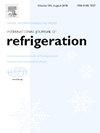室内空调蓄能器中制冷剂-润滑油混合物动态回液特性的数值模拟与实验验证
IF 3.5
2区 工程技术
Q1 ENGINEERING, MECHANICAL
International Journal of Refrigeration-revue Internationale Du Froid
Pub Date : 2025-06-25
DOI:10.1016/j.ijrefrig.2025.06.026
引用次数: 0
摘要
室内空调采用蓄压器向压缩机供应蒸汽制冷剂和液体制冷剂-润滑油混合物,返回压缩机的液体混合物过多或不足分别可能导致液段塞或缺油,造成压缩机损坏。在精确仿真的基础上对蓄能器进行优化设计是合理调节回液率的有效途径。本文的目的是建立一个蓄能器仿真模型,并通过实验对其进行验证。在该模型中,建立了蓄能器腔内气相和液相的质量守恒方程和能量守恒方程,以反映两相的流动过程;为了描述气液界面的流动过程,建立了制冷剂溶解和解吸速率的计算公式;建立了基于流道划分的压力平衡方程,以反映进出口管道内的流动过程。建立了储液器回液率、回油率和液位高度的实验装置,验证结果表明,预测值与实验值的平均绝对偏差分别为6.3%、8.7%和4.6%。利用该模型对额定制冷量为3.5 kW的室内空调蓄能器放油孔结构参数进行了优化,优化结果表明,放油孔直径和高度的合理范围分别为0.65 ~ 0.92 mm和15 ~ 30 mm。本文章由计算机程序翻译,如有差异,请以英文原文为准。
Numerical simulation and experimental validation of dynamic liquid-return characteristics of refrigerant-lubricating oil mixtures in accumulator of room air-conditioner
Room air-conditioners adopt accumulators to supply vapor refrigerant and liquid refrigerant-lubricating oil mixture to the compressors, and the excessive or insufficient liquid mixture returning to the compressor may respectively lead to liquid slugging or oil starvation, resulting in compressor damage. Optimization design of the accumulator based on accurate simulation is an effective way to appropriately regulate the liquid return rate. The purpose of this paper is to develop a model for accumulator simulation and to validate it by experiments. In the model, the mass and energy conservation equations for both vapor phase and liquid phase within the accumulator cavity are established to reflect the flow processes in two phases; the equations for calculating the refrigerant dissolution and desorption rates are formulated to describe the flow process of vapor-liquid interphase; the pressure balance equations based on flow path divisions are formulated to reflect the flow processes in the inlet and outlet pipes. An experimental rig is built to measure liquid return rate, oil return rate and height of liquid level of the accumulator, and the validation results show that the mean absolute deviations between predicted and experimental data of those three parameters are 6.3 %, 8.7 % and 4.6 %, respectively. By using the model, the structural parameters of the oil bleed hole for a room air conditioner accumulator with a rated cooling capacity of 3.5 kW were optimized, and the optimization results indicate the reasonable ranges for the diameter and the height of oil bleed hole are 0.65–0.92 mm and 15–30 mm, respectively.
求助全文
通过发布文献求助,成功后即可免费获取论文全文。
去求助
来源期刊
CiteScore
7.30
自引率
12.80%
发文量
363
审稿时长
3.7 months
期刊介绍:
The International Journal of Refrigeration is published for the International Institute of Refrigeration (IIR) by Elsevier. It is essential reading for all those wishing to keep abreast of research and industrial news in refrigeration, air conditioning and associated fields. This is particularly important in these times of rapid introduction of alternative refrigerants and the emergence of new technology. The journal has published special issues on alternative refrigerants and novel topics in the field of boiling, condensation, heat pumps, food refrigeration, carbon dioxide, ammonia, hydrocarbons, magnetic refrigeration at room temperature, sorptive cooling, phase change materials and slurries, ejector technology, compressors, and solar cooling.
As well as original research papers the International Journal of Refrigeration also includes review articles, papers presented at IIR conferences, short reports and letters describing preliminary results and experimental details, and letters to the Editor on recent areas of discussion and controversy. Other features include forthcoming events, conference reports and book reviews.
Papers are published in either English or French with the IIR news section in both languages.

 求助内容:
求助内容: 应助结果提醒方式:
应助结果提醒方式:


